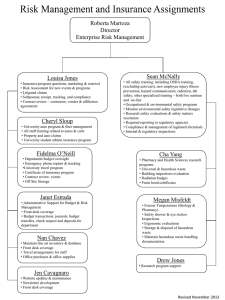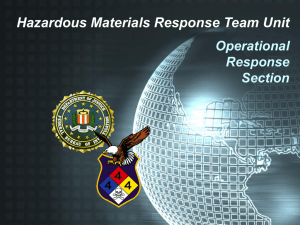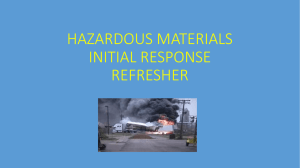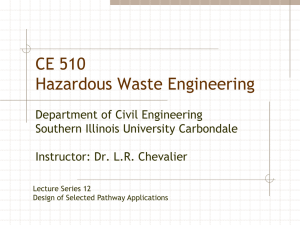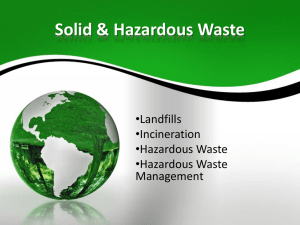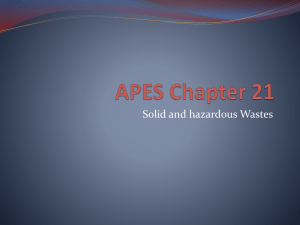CE 510 Hazardous Waste Engineering
advertisement
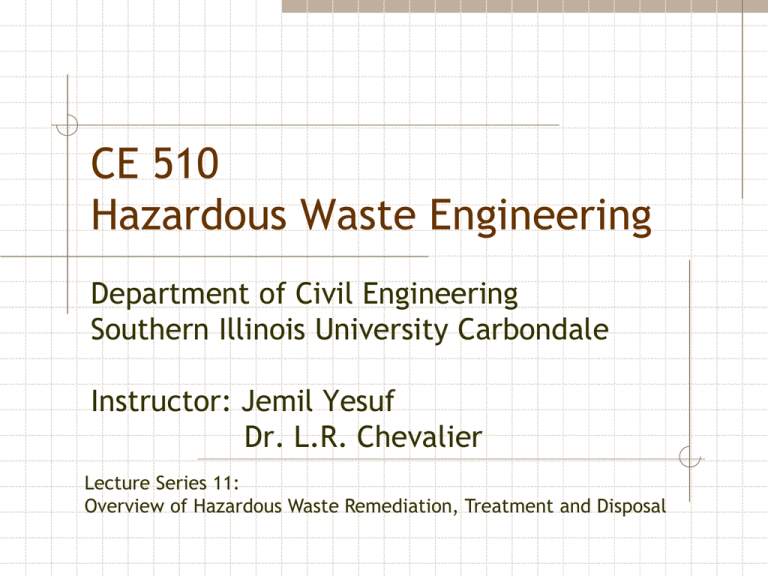
CE 510 Hazardous Waste Engineering Department of Civil Engineering Southern Illinois University Carbondale Instructor: Jemil Yesuf Dr. L.R. Chevalier Lecture Series 11: Overview of Hazardous Waste Remediation, Treatment and Disposal Course Goals Review the history and impact of environmental laws in the United States Understand the terminology, nomenclature, and significance of properties of hazardous wastes and hazardous materials Develop strategies to find information of nomenclature, transport and behavior, and toxicity for hazardous compounds Elucidate procedures for describing, assessing, and sampling hazardous wastes at industrial facilities and contaminated sites Predict the behavior of hazardous chemicals in surface impoundments, soils, groundwater and treatment systems Assess the toxicity and risk associated with exposure to hazardous chemicals Apply scientific principles and process designs of hazardous wastes management, remediation and treatment Major Concepts Top priority is waste minimization and pollution prevention Reduction Recycling Second tier of waste management is treatment Emphasis on the destruction of the hazardous chemicals Selection of treatment processes based on Properties of chemical(s) Concentrations Complexity of the matrix Major Concepts Final option is long-term containment with no treatment Landfill disposal However, landfill disposal represents a long-term threat of potential environmental releases Hence low priority as a management alternative Priorities in hazardous waste management, minimization and prevention Waste Generation Source and Volume Reductions •Materials substitution •Segregation •Reuse •Process modification Recycling •Solvents •Process water •Acids Treatment •pH neutralization •Metals removal •Organic removal •Thermal treatment Disposal •Landfills Hierarchy of Source Removal and Remediation Methods First Priority Drums Tanks Sludges Other containers of source materials (e.g. bags, bins, etc.) Second Priority Contaminated surface soils Contaminated subsurface solids LNAPL DNAPL Third Priority Contaminated groundwater Contaminated surface waters Second Priority: LNAPL Second Priority: DNAPL Hazardous Waste Treatment Ex-situ processes - Removal Removal – treatment - disposal Groundwater Vadose zone subsurface soil Surface soil More expensive than in-situ Easier to control than in-situ http://www.frtr.gov/matrix2/section1/list-of-fig.html#2 treatment Injection well Recovery well groundwater flow contaminated region Pump-and-treat Hazardous Waste Treatment In-situ “in place” No excavation Groundwater is not pumped out and treated Less labor intensive (cost savings) Minimal site disturbance Hazardous Waste Treatment: Effects of Sorption Contaminant Saturation conc. dC dt k C s C Coefficient for contaminant desorption Contaminant conc. In aqueous phase Hazardous Waste Treatment: Effects of Sorption Effects of sorption on groundwater remediation through 1) asymptotic approach to reaching clean-up levels and 2) the release of contaminants to the aqueous phase after the pump-and-treat process has stopped Because of the dependence of pump-and-treat groundwater remediation on sorption/desorption, its use has been in decline. Hazardous Waste Treatment: Reactor Analysis Most designs and analyses of engineering processes are based on mass balance and reactor analysis Three models Batch Reactors CFSTRs Plug- flow reactors Hazardous Waste Treatment: Reactor Analysis Batch Reactors No influent or effluent Wastes treated by adding reagents First order reaction is expressed as C Co e kt Hazardous Waste Treatment: Reactor Analysis Continuous flow stirred tank reactors (CFSTR) Effluent concentration is the same as the concentration in the reactor First order reaction is expressed as C Co 1 1 k Hazardous Waste Treatment: Reactor Analysis Plug-flow reactors (PFR) Characterized by no mixing or dispersion Water moves in a “plug” through the reactor First order reaction is expressed as C Co e k Textbook Problem 12.18 A groundwater containing 560 µg/L of tolune is to be treated to 5 µg/L in a plug-flow UV/H2O2 reactor. If the steadystate hydroxyl radical concentration is 2x10-10 M, determine the required detention time in the reactor. kOH- for tolune is 4x109. Hazardous Waste Treatment: Reactor Analysis Almost all hazardous waste treatment systems are designed using reactor fundamentals See figures 12.9 through 12.11 Classification of Remediation and treatment Processes Environmental engineering treatment systems classification: Physiochemical Biological Hazardous waste treatment systems are complex due to: Thousands of contaminants Widely varying concentration and characteristics Treatment required for different media Classification of Remediation and treatment Processes Classification of remedial and treatment technologies based on pathways and function - Sorption Volatilization Abiotic Biotic Neutralization Stabilization Thermal processes http://www.frtr.gov/matrix2/section1/list-of-fig.html#2 Sorption Processes GAC, Ion Exchange , Stabilization (a.k.a. Solidification or fixation), soil washing and thermal desorption GAC High surface area: 1000-1400 m2/g Hydrophobic surface characteristics GAC made from many sources: Wood Bituminous coal materials Coconut shells and Nutshells Lignite GAC Treatment Dynamics of gravity flow GAC treatment Influent Exhausted carbon Adsorption zone (MTZ) Unused carbon Effluent Stabilization Stabilization: Addition of stabilizing material to hazardous waste so as to alter the chemistry of the waste and render it less toxic, less mobile and less soluble Solidification: the modification of a liquid or slurry waste to a solid material by adding solids or other reagents Wastes treated by stabilization Liquid and slurry organic and inorganic hazardous wastes generated under RCRA Hazardous wastes at contaminated sites Residuals from other treatment processes Stabilization Agents Organic agents: Organically modified lime Organic polymers (polyethylene) Bitumen Asphalt Inorganic agents: Cement, Lime Volatilization Processes Air stripping, Soil Vapor Extraction (SVE) Air stripping has been used for decades for the removal of ammonia, sulfur dioxide, and hydrogen sulfide from water When hazardous waste is stripped from aqueous phase into gaseous phase, contaminants may become hazardous air pollutants Hence, GAC scrubbers and other secondary process modifications are implemented to lower concentration below regulation levels SVE SVE is a cleanup technology commonly used to remove VOCs and semi-VOCs from the vadose zone or from piles of excavated soils Most important variables for SVE process selection include Porosity, and Contaminant volatility SVE is one of the most accepted remediation technology since 1970s SVE has been used in 25% of the 170 superfund sites Physical components of SVE include: A vapor extraction well, a vacuum blower, air water separator, and vapor treatment system (GAC or biofilters) Abiotic Transformation processes Chemical oxidation/reduction: converts HWs to non- hazardous or less toxic compounds that more stable, less mobile, and/or inert states. Involves the transfer of electrons from one compound to another, i.e., one reactant is oxidized (loses electrons) and one is reduced (gains electrons) Most common design application is the Advanced oxidation processes (AOPs) with oxidizing agents such as: Ozone, UV/ozone, H2O2/ozone, UV/H2O2 Fentons’s Reagent (H2O2/catalysts) Class example If (a) O3 is present at 10-5 mM or (b) OH· at 10-5 mM, what is the time required to oxidize 10 mg/L TCE to 1 µg/L TCE? The rate constant for the reaction of ozone with TCE is 17 M-1sec-1. Assume oxidant concentrations are constant. Biotic Transformation processes Application of biological processes Bioremediation techniques are destruction techniques directed toward stimulating microorganisms to grow and use the contaminants as a food and energy source The main process variables in the design and operation of bioremediation include: Oxygen supply pH Bioavailability Nutrients Toxicity Temperature Biotic Transformation processes Electron donor source Recovery well Terminal electron acceptor Nutrients Injection well Plume of sorbed contaminants GW flow An in situ groundwater bioremediation system Other Treatment processes Bioventing Landfarming Thermal processes-Incineration Air sparging Phytoremediation Biopiles Composting Slurry phase biological treatment More reference on remediation technologies can be accessed at http://www.frtr.gov/matrix2/top_page.html Ultimate Disposal- HW Landfills Primary goals of HW management are: Minimization and pollution prevention Treatment (emphasis on destruction) Some HWs cannot be minimized or treated E.g. some PCBs and metal bearing soils, residues from other treatment processes Hence, need for Landfill disposals Landfills are designed to contain waste, while minimizing releases to environment See figs. 12.22 and 12.23 Summary of Important Points and Concepts The priorities of managing HWs, in decreasing order of importance, are minimization/prevention, treatment/remediation, and disposal. HW minimization efforts hold the potential of decreasing the mass, volume and toxicity of wastes at the source HW remediation and treatment processes may be considered applications of hazardous waste pathways. Therefore, treatment processes may be grouped into sorption, volatilization, abiotic transformation, and biotic transformation processes. Another class-Thermal processes Summary of Important Points and Concepts HW remediation and treatment processes may also be classified by schemes such as in situ and ex situ processes OR as RCRA wastes or CERCLAtype HW sites. Treatment process selection and design requires consideration of the contaminant characteristics and the matrix of the waste (i.e., liquid, soil, sludge, etc.) Almost every HW management system may be conceptualized as a reactor as a basis for analysis and design.


